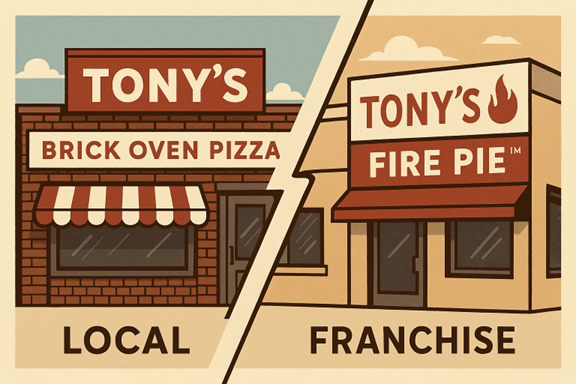
IP Monday Law Blog
 The following is a hypothetical story meant for general educational purposes and is not based on any real-life business or dispute. Readers should consult an attorney prior to taking action to determine how this information may apply to a specific situation.
The following is a hypothetical story meant for general educational purposes and is not based on any real-life business or dispute. Readers should consult an attorney prior to taking action to determine how this information may apply to a specific situation.
When the Dough Rises Too Close to Home
Fictional Scenario: For 30 years, Tony’s Brick Oven Pizza has been the pride of downtown Lansing, Michigan. Same family, same oven, same neighborhood aroma that says: 'Friday night is pizza night.' Then one day, Tony gets a letter. A fast-growing national chain called Tony’s Fire Pie™, barely 10 years old, plans to open a franchise just a few miles away.
This fictional scenario illustrates the modern challenge of trademark geography. In trademark law, being first isn’t enough—it also matters where you were first.
The Local Legend vs. The National Newcomer
Tony’s Brick Oven Pizza has common-law trademark rights, earned through years of use in his community. The chain, however, owns a federal registration for 'Tony’s Fire Pie®,' which creates constructive nationwide rights. The legal question: Who owns the 'Tony’s' name? The answer depends on geography and in today’s world, geography travels by Wi-Fi.
The Old Rule: Stay in Your Lane
For decades, the Tea Rose–Rectanus rule allowed two businesses to coexist if they were far apart and acted in good faith. If you were baking in Lansing, Michigan and the other Tony’s was tossing dough in Tucson, Arizona, you could both live happily ever after.
COVID Changed the Map
Then came food delivery apps: Uber Eats, DoorDash, and Grubhub extended Tony’s customer base far beyond Lansing. Now Tony’s sells to Michigan State University (MSU) students, alumni, and even out-of-state fans ordering frozen pies. Meanwhile, the national chain runs ads across Michigan. Suddenly, both Tony’s exist in the same digital neighborhood.
The Law Is Catching Up
Courts once followed the Dawn Donut rule, no conflict until both parties actually compete in the same geographic market. But in today’s digital world, separate markets rarely exist. Now, digital presence often equals market presence.
Lessons for Small Businesses
While this story is fictional, the takeaways are real. Lessons that business owners can take away from this include:
- File early: A federal registration provides nationwide protection.
- Track your reach: Delivery ZIP codes and analytics show your true footprint.
- Monitor overlap: Digital competition can create real conflicts.
- Consider coexistence: Sometimes, carving up the map is better than fighting.
Final Slice
The fictional Tony’s Brick Oven Pizza reminds us that trademark geography isn’t just about city limits anymore. In the post-COVID world, your brand travels as far as your delivery radius and Wi-Fi reach. Protect your name early, think beyond the map, and remember — in the digital age, even a local pizza shop competes on a national stage.
- Senior Attorney
Mikhail "Mike" Murshak is a licensed patent attorney and experienced Intellectual Property (IP) attorney specializing in patent, trademark strategy and acquisition, and general IP and business counseling including ...

